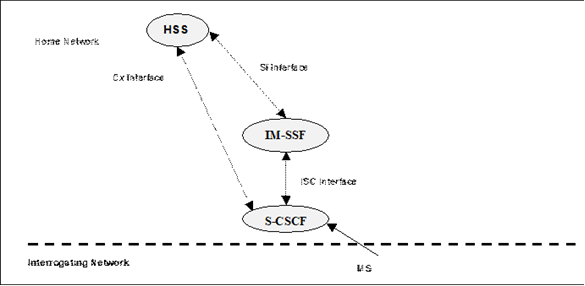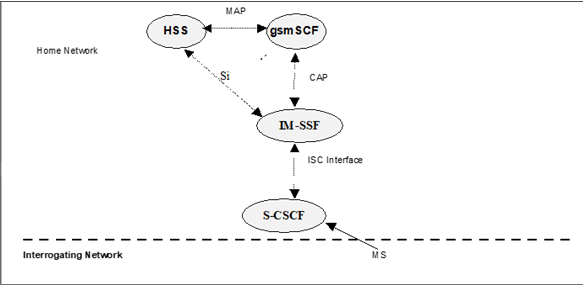Content for TS 23.278 Word version: 17.0.0
1…
4…
4.4…
4.6…
4.6.1.1
4.6.1.2
4.6.1.3
4.6.1.4
4.6.1.5
4.6.1.6
4.7…
4.7.2…
4.7.3…
4.7.4…
4.7.5…
5…
6…
4 CAMEL/IP Multimedia Core Network Interworking
4.1 Architecture
4.1.1 Functional Entities used for CAMEL at IP Multimedia Registration
4.1.2 Functional Entities used for CAMEL for MO and MT IP Multimedia session
4.2 Interfaces defined for an IM-SSF based Application Server
4.2.1 CSCF - IM-SSF interface
4.2.2 IM-SSF - gsmSCF interface
4.2.3 HSS - IM-SSF interface
4.3 Detection Points (DPs)
4.3.1 Arming/Disarming mechanism
4.3.2 Criteria
...
...
4 CAMEL/IP Multimedia Core Network Interworking p. 10
4.1 Architecture p. 10
This clause describes the functional architecture needed to support CAMEL interactions with the S-CSCF in the IP Multimedia Subsystem. The IM-SSF is a SIP Application Server that interfaces SIP to CAP. The generic SIP Application Server behaviour of the IM-SSF is specified in TS 23.218.
4.1.1 Functional Entities used for CAMEL at IP Multimedia Registration p. 10
Figure 4.1 shows the functional entities involved when an MS registers for IP Multimedia session requiring CAMEL support. General registration procedure is detailed in TS 23.228. Upon notification of a UE's registration, the IM-SSF requests O-IM-CSI, D-IM-CSI, VT-IM-CSI data from the HSS over the Si interface.

Figure 4.1: Functional architecture for support of CAMEL when mobile registers for IP Multimedia session
(⇒ copy of original 3GPP image)
(⇒ copy of original 3GPP image)
4.1.2 Functional Entities used for CAMEL for MO and MT IP Multimedia session p. 11
Figure 4.2 shows the functional entities involved in a Mobile Originated IP Multimedia session requiring CAMEL support. The same functional architecture applies in a Mobile Terminated IP Multimedia session for CAMEL.

Figure 4.2: Functional architecture for support of CAMEL control of a MO IP Multimedia session
(⇒ copy of original 3GPP image)
(⇒ copy of original 3GPP image)
4.2 Interfaces defined for an IM-SSF based Application Server p. 11
4.2.1 CSCF - IM-SSF interface p. 11
This interface is the IP Multimedia Service Control interface (ISC). This interface shall be based on SIP as detailed in TS 24.229.
4.2.2 IM-SSF - gsmSCF interface p. 11
This interface is used by the gsmSCF to control an IP Multimedia session in a certain IM-SSF. Relationships between the IM-SSF and the gsmSCF on this interface are opened as a result of the IM-SSF sending a request for instructions to the gsmSCF. This interface shall be based on TS 29.278.
4.2.3 HSS - IM-SSF interface p. 11
This interface is the Si interface and is used to send CAMEL related subscriber data to the IM-SSF, e.g. IM-CSI. This interface shall be a MAP interface as described in TS 29.002.
4.3 Detection Points (DPs) p. 11
Certain basic call events may be visible to the GSM Service Control Function (gsmSCF). The DPs are the points in call at which these events are detected.
A DP can be armed in order to notify the gsmSCF that the DP was encountered, and potentially to allow the gsmSCF to influence subsequent handling of the call. If the DP is not armed, the processing entity continues the processing without gsmSCF involvement.
Three different types of DPs are identified:
- Trigger Detection Point - Request (TDP-R). This detection point is statically armed and initiates a CAMEL control relationship when encountered and there is no existing relationship due to the same CSI. Processing is suspended when the DP is encountered.
- Event Detection Point - Request (EDP-R). This detection point is dynamically armed within the context of a CAMEL control relationship. Processing is suspended when encountering the DP and the IM-SSF waits for instructions from the gsmSCF.
- Event Detection Point - Notification (EDP-N). This detection point is dynamically armed within the context of a CAMEL control relationship. Processing is not suspended when encountering the DP.
4.3.1 Arming/Disarming mechanism p. 12
A DP may be statically armed or dynamically armed.
The following arming rules apply:
- DP for a mobile originating call handling is statically armed in the IM-SSF as a result of O-IM-CSI and D-IM-CSI data delivery from the HSS. Likewise, DP for mobile terminating call handling is statically armed in the IM-SSF as a result of VT-IM-CSI data delivery from the HSS. Static arming of DPs in the IM-SSF occurs during the UE's registration in the IMS CN. Basically, when the IM-SSF is notified of the UE's initial registration, the IM-SSF queries the HSS for the subscriber's CAMEL Subscription Information via the Si interface.
- A DP is dynamically armed by the gsmSCF within the context of a CAMEL control relationship as a result of IM-SSF receiving the RequestReportBCSMEvent operation.
- A Request Report BCSM Event information flow for a detection point for a leg overwrites any previous Request Report BCSM Event information flow for that detection point for that leg.
- A statically armed DP is disarmed when the IP Multimedia CSI data is withdrawn in the HSS. Only TDP-Rs can be disarmed using this mechanism.
- If an armed EDP is met, then it is disarmed.
- If an EDP is met that causes the release of the related leg, then all EDPs related to that leg are disarmed.
- If a call session is released, then all EDPs related to that call session are disarmed.
- If an EDP is met, then other EDPS are disarmed, in accordance with the implicit disarming rule table specified in TS 23.078 Rel-99 4 (refer to the clause for "Rules for Implicit Disarming of Event Detection Points").
4.3.2 Criteria p. 12
Criteria are the conditions that must be met in order for the IM-SSF to request instructions from the gsmSCF.
DP criteria are checked in the IM-SSF. Criteria for originating DPs (i.e. Collected_Info, Analysed_Information, and Route_Select_Failure TDPs ) are checked in the IM-SSF associated with the originating UE's S-CSCF. Criteria for terminating DPs (i.e. T_Busy and T_No_Answer) are checked in the IM-SSF associated with the terminating UE's S-CSCF.
Based on the Initial Filter Criteria information, the S-CSCF forwards the SIP message to the IM-SSF. The DP encountered is identified based on the SIP message received from the S-CSCF. Refer to Table 4.2 and Table 4.4 for mapping of SIP messages to CAMEL IM-BCSM Detection Points.
4.3.2.1 Criteria at Collected_Info p. 13
The following criteria are applicable for DP Collected_Info:
- Destination number triggering criterion: The HSS may store a list of up to 10 destination numbers and/or up to 3 number lengths. There is no restriction on the nature of address. There is no restriction on the numbering plan indicator. This criterion may be defined to be either "enabling" or "inhibiting". This criterion does not match when the destination number received from the S-CSCF is not an ISDN number. In this case, a dialogue with the gsmSCF may or may not be established depending on whether the criterion is inhibiting or enabling respectively.
- the destination number matches one of the destination number strings defined in the list; or
- the length of the destination number matches one of the destination number lengths defined in the list.
- the nature of address of destination number is the same as the nature of address of the destination number string;
- the destination number is at least as long as the destination number string in the list; and
- all the digits in the destination number string in the list match the leading digits of the destination number.
- the destination number does not match any of the destination number strings defined in the list; and
- the length of the destination number does not match any of the destination number lengths defined in the list.
- the nature of address of destination number is the same as the nature of address of the destination number string;
- the destination number is at least as long as the destination number string in the list; and
- all the digits in the destination number string in the list match the leading digits of the destination number.
4.3.2.2 Criteria at DP Analysed_Information p. 13
4.3.2.2.1 General p. 13
The following criteria are applicable for DP Analysed_Information:
- Destination number triggering criterion: The HSS may store a list of up to 10 destination numbers. There is no restriction on the nature of address. There is no restriction on the numbering plan indicator. This criterion does not match when the destination number received from the S-CSCF or the gsmSCF is not an ISDN number.
4.3.2.2.2 Number comparison p. 13
The following procedure shall be performed for the comparison of the destination number triggering criterion and the address information in the given order.
- The numbering plan indicators of both numbers are ignored.
- The type of number/nature of address indicators of both numbers are compared. If there is a match of the type of number indicator, then the check shall be performed by comparing the digits as defined in step 6. If there is no match of the type of number the comparison procedure shall continue as follows.
- If either or both of the address information and destination number triggering criterion includes a type of number/nature of address indicator other than "unknown", "national (significant) number" or "international number" then the destination number does not match the destination number triggering criterion. Otherwise the comparison procedure shall continue as follows.
-
If there is a number (address information or destination number triggering criterion) with type of number/nature of address "unknown" this number shall be translated based on the numbering plan of the serving entity in either of the following ways:
- if the leading digits refer to an international prefix, those digits shall be removed and the type of number/nature of address shall be set to "international number".
- if the leading digits refer to a national (trunk) prefix, those digits shall be removed and the type of number/nature of address shall be set to "national (significant) number".
- If the type of number/nature of address of the address information or of the destination number triggering criterion is "national (significant) number" this number shall be translated based on the numbering plan of the serving entity to international format by adding the country code of the serving entity to the number string. After this modification both numbers shall be in international format and shall be checked by comparing the digits as defined in step 6.
-
If the number digits of the address information are compared with the number digits of the destination number triggering criterion, then there is a match if:
- the destination number is at least as long as the destination number string of the destination number triggering criterion; and
- all the digits in the destination number string of the destination number triggering criterion match the leading digits of the destination number.
4.3.2.3 Criteria at DP Route_Select_Failure p. 14
The HSS may store a list of up to 5 cause values.
The following criteria are applicable for DP Route_Select_Failure:
- Release cause code.
4.3.2.4 Criteria at DP T_Busy and T_No_Answer p. 15
The HSS may store a list of up to 5 cause values.
The triggering is based on the release cause code received from terminating UE's P-CSCF.
The following criteria are applicable for DP T_Busy and T_No_Answer:
- Release cause code.